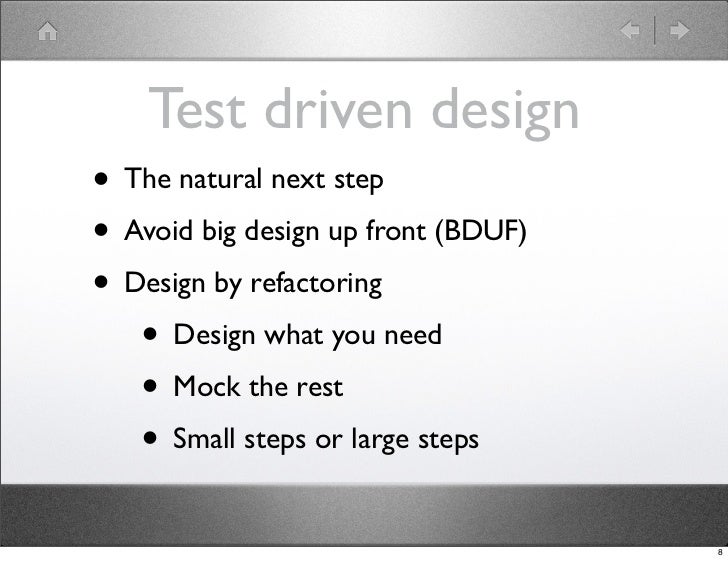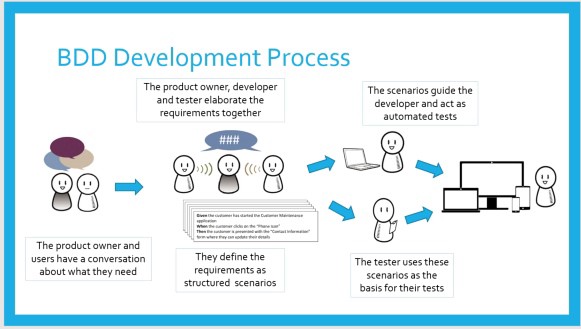Table Of Content
- Scaling TDD via Agile Model-Driven Development (AMDD)
- The Power of Prototyping in Design, Part 1: Turn Ideas into User-Centric Solutions
- What is Test-driven Development? A Complete Guide To TDD
- Concept and Benefits of TDD
- Exploring the Advantages and Comparing TDD with BDD: Practical Examples Highlighting Different Approaches

To a surprise, TDD coders had finished and produced more reliable code than the developers who wrote unit tests. Unit testing has been there since the inception of programming. However, the methods of unit testing have evolved over the years. TDD is about writing the test code before writing the production code. In Agile development, TDD ensures that the code is working as intended and that new modifications to the base code do not break existing functionality. It is also used to improve the quality of the codebase and to reduce the overall cost of software development.
Scaling TDD via Agile Model-Driven Development (AMDD)

Overall, TDD offers a more efficient and reliable approach to software development, ensuring that code is thoroughly tested before being integrated into the system. Traditional testing, however, may be more appropriate for larger and more complex projects where a more comprehensive approach to testing is required. A development approach where tests are written before the actual code. Developers write tests, then implement code to pass those tests.
The Power of Prototyping in Design, Part 1: Turn Ideas into User-Centric Solutions
Like many new developers, I was lost as to how to even get started. After surveying the landscape, here's why I think testing is hard. In this introductory post, you'll build a beginner foundation for TDD. We'll learn about what TDD is, what makes it important, and how developers are using it to consistently deliver value on real-life projects. We'll also discuss what makes testing so challenging to get right, and in the end, we'll wrap up with a demonstration of the Classic TDD process, using TDD to construct a palindrome checker. It brings together developers, testers and customers to discuss the requirements before any code is written.

What is Test-driven Development? A Complete Guide To TDD
For example, in traditional code-first unit testing, a test might consist of testing all decisions in a coding construct. This is the opposite of the more commonly applied approach, as described above. In the “code, text, fix” approach, the developer often performs tests, but the thing to observe is that the code is written first, then the unit or component tests are performed based on the code.
Test-driven development
We’d love to talk with you about your next great software project. Fill out this form and we’ll get back to you within two business days. As designers, I think we all probably have had these thoughts from time to time.
However, this approach still proved costly and time-consuming, even in an age where code can be written, changed, and built very quickly. Classic TDD (also known as Inside Out or Chicago style TDD) is a style of unit testing where we start from the unit tests, and build outwards, fleshing out the internal details of the objects we know we need. This is probably the most straightforward and commonly known form of TDD. I didn't start writing tests until later in my career. When I first started out, I knew that we should probably have them, but as for writing them?
Exploring the Advantages and Comparing TDD with BDD: Practical Examples Highlighting Different Approaches
It was listed alongside Scrum and XP when in fact TDD is a practice that can used within these methodologies. Likewise, results from other studies during this period must be analysed in the context of how TDD was defined or interpreted. Kent Beck codes the first version of SUnit test framework for Smalltalk.
Developer-driven development - hackernoon.com
Developer-driven development.
Posted: Thu, 03 Nov 2016 07:00:00 GMT [source]
Let’s take a look at Test-Driven Development, one of the core practices of agile software development. When a developer goes to create a new feature, the first step is to write an acceptance test and then watch it fail. (If the test passes, this is a problem — either the feature exists, or the test is defective.) Next, the developer writes code and runs the test again. He continues writing code and running the test, until the test passes.
Managing tests for large teams
It is extended on the TDD approach to improving the collaboration between developers, testers, and business participants. It is also frequently related to Agile methodologies. Testing frameworks may accept unit test output in the language-agnostic Test Anything Protocol created in 1987. There are many testing frameworks and tools that are useful in TDD. The Best Colleges for Design majors ranking is based on key statistics and student reviews using data from the U.S. The ranking compares the top design schools in the U.S.
TDD is complicated, with many different interpretations over what it means to do it properly and how to use it to get the biggest benefits for your code. Some developers swear by TDD, saying it gives them the confidence to take coding risks. At this point, we have finished our piece of art (implementation). With TDD in mind, we have needed minimal code changes to pass all the test cases and satisfy all requirements with refactoring, ensuring that we have great code quality (performance, readability, and design). We have an opportunity to refactor here but we will not take it in this step. In the implementation phase, our only goal is to make the test pass and give us a green bar.
Applying these practices consistently can help improve the quality, maintainability and testability of your codebase. Additionally, exploring other practices like continuous integration, code coverage analysis and test refactoring can further enhance your TDD workflow. This module provides an overview of how to use Behave to generate Python steps. Once you know how to generate the steps, you will learn the workflow for implementing them.
It’s that following the practice of TDD necessarily shapes the way the developer thinks about designing and building their application. This article describes the TDD approach in detail, along with its stages, examples, and benefits in software development. The evolution of Agile development has introduced many pragmatic practices for delivering quality software at high speed. Test-Driven Development (TDD) is a practice now recognized as an efficient approach that drives positive results. Regression testing is a separate step and may require additional effort to ensure that new changes don't break existing functionality. Built-in regression testing as tests are run frequently.
Historical data of your previous developments help setting the best set of test design techniques to reach a cost optimum and high quality together. In lack of historical data some assumptions can be made, which should be refined for subsequent projects. ” Maybe your users point out a few minor things, or express an opinion about the shade of green that you used, but they don’t have a lot of trouble with the application. ” moments, everything works as expected, and the users are generally happy.
No comments:
Post a Comment